Nothing is more important than providing excellent customer service as a contact center.
After all, more than half of Americans have scrapped a planned purchase or transaction because of bad service, which results in U.S. companies losing more than $62 billion a year.
It can be challenging for many contact centers to grade their customer service interactions. It would help if you had feedback and insight into how your agents interact with customers every single time.
That’s why customer service scorecards are a game-changer.
Customer service scorecards are an evaluation system designed to measure contact center performance at every step.
They help you gain feedback about where your agents meet the expectations of a quality customer experience. And they also delve into how well your agents follow all the correct processes and compliance standards to achieve the outcomes you want.
Customer service scorecards provide a QA form to tell you how well or how poorly your agents handle every customer service interaction based on customizable criteria.
Scorecards make feedback measurable, and concrete to more easily hold your agents accountable and create improvement plans.
Not only are customer service scorecards essential for monitoring overall contact center performance, but they are also necessary for training.
They can help you identify trends and learning gaps to reveal skills, areas, and processes that are lacking. This is essential for improvement.

So, how do you build an effective customer service scorecard?
First, you have to establish your goals and objectives and align those with your agent's activities - you then need to create a grading rubric for your agents to use as a guide.
This might not be a quick process, but it’s also not as difficult as you think. The key is to use software for your customer service scorecard, instead of a spreadsheet.
While spreadsheets are cheap and easy to use as scorecard templates, they entirely completely manual; plus, there’s no protection from human error. Spreadsheets are practical for static and simple formulas, but complex data, forecasting, and monitoring are impossible.
On the other hand, software that makes it easy to build a customer service scorecard is far more efficient, accurate, and usable. The software can help you improve productivity and quality in customer service monitoring, and it provides a far more in-depth review.
After all, to be helpful, a scorecard must be relevant, organized, and timely, and that requires a system that can ask dynamic questions and be adjusted as needed.
To serve your customers and call center better, you need a powerful customer service scorecard tool to streamline the QA process. It should make it easy to gather a high volume of data and categorize it.
Scorebuddy’s digital QA scorecards - which we’ll talk more about at the end of this blog - are a great place to start collecting, analyzing, reporting, and making decisions on customer service data.
And the good news is that Scorebuddy’s customer service scorecards are 100% customizable to your needs and the elements you find most essential to success.
The question is, “What should you include on your customer service scorecard?”
While it’s up to your business priorities and customer service needs, some key elements should always be included.
There are ten critical areas to monitor on your customer service scorecard.
Your agents’ soft skills are a critical predictor of customer experience. Without the right skills, your agents won’t be able to deliver customer support successfully. You need to test your agents’ ability to:
A few questions you should include on your customer service scorecard for soft skills are:
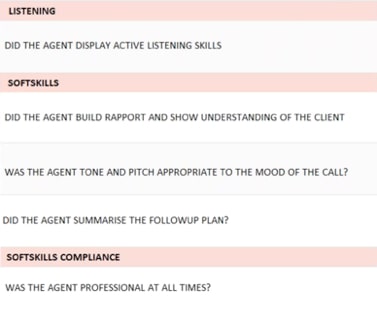
Then, based on your soft skills monitoring results, you need to implement soft skills training. This training should be specific, measurable, attainable, relevant, time-based, and delivered via blended learning.
Follow these six steps for soft skills training for more information.
There are many internal processes that your contact center agents must follow for effective customer service.
These processes ensure efficient handling of customer service inquiries and ensure that your agents know the procedures they need to follow for successful outcomes. Your agents must understand and follow all of your internal processes.
Some process questions to include on your customer service scorecards include:
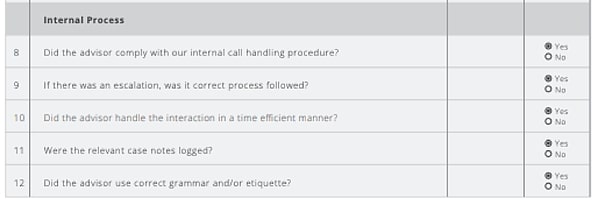
High-quality customer service requires a deep and broad understanding of your company’s products/services.
Your contact center agents must be ready and able to handle any customer questions and concerns regarding your products.
The key is to manage customer expectations regarding their ability to fix product issues and ensure the correct problem is addressed effectively.
There are a few product competency questions to include:

Your agents need to be able to grade their customer service interactions—no matter how the customer contacts your call center.
If you offer omnichannel customer support, you need scorecards unique to each channel—phone, chat, email, etc.
Phone Criteria
A customer service scorecard for phone calls should rate your agent’s ability to demonstrate confidence and enthusiasm while following predetermined procedures.
In particular, the scorecard should at least cover the seven most essential elements of every call:
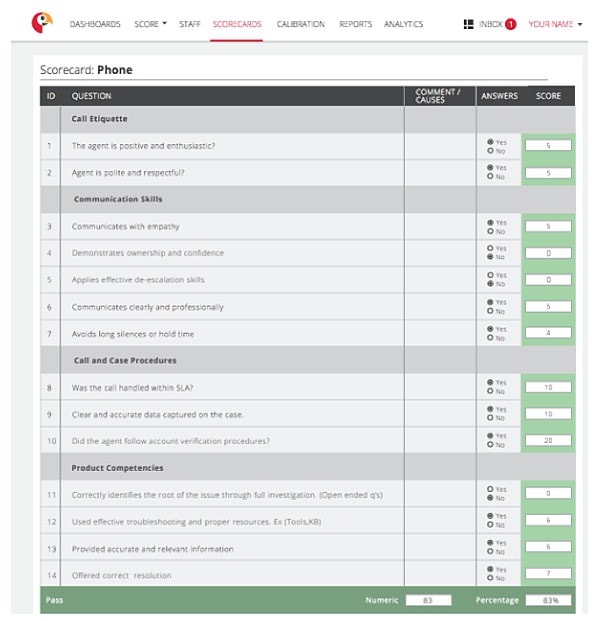
Chat Criteria
Chat is another popular customer service support channel. And it does require different agent monitoring than a phone call.
Effective that focuses more intensely on quick responses, proper grammar, immediate remediation, and following procedures.
A few key elements to include on your chat scorecard are:
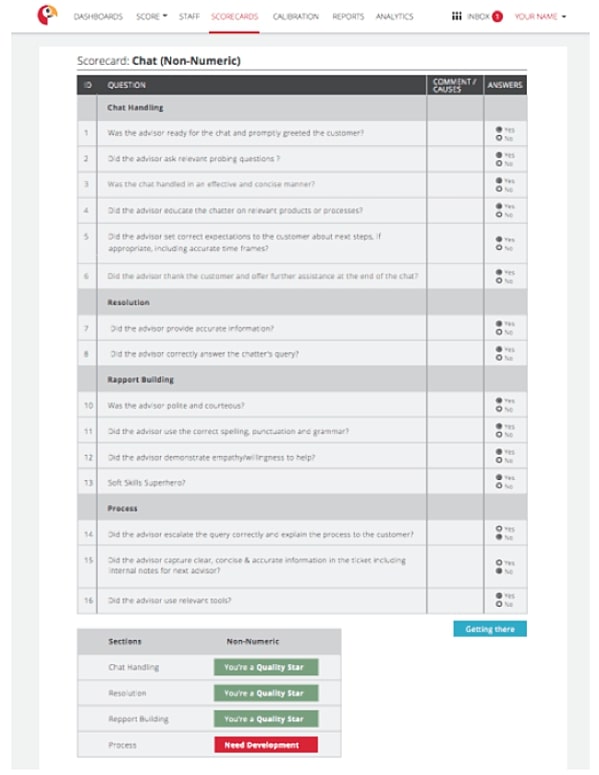
Email Criteria
Your agents that respond via email must also be evaluated using a different set of customer service scorecard criteria.
In email responses, tone of voice, using the customer’s name, proper grammar, and detailed information is critical.
You need to ensure that their written customer service response is adequate, uses your knowledge base, and meets the customer’s needs.
Email-focused questions to include:
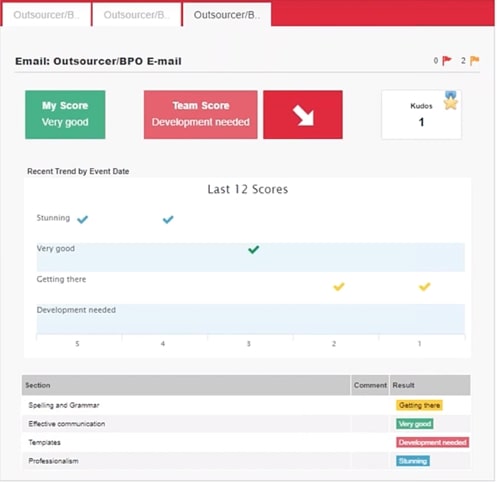
Not all customer service inquiries are the same, and understanding the type of inquiry is critical to identifying areas of success and improvement.
On your scorecard, provide a section where you can segment and categorize each type of request.
First, define your customer service categories:
Then, describe what tier of ticket it was:
With this information, you can more effectively grade how well the agent dealt with the customer and achieved the desired outcome.
This information will also explain any transferring, escalations, or poor performance in KPIs.
Contact centers have to follow strict guidelines and standards for customer service. All organizations need to be concerned with regulatory compliance, security, and consent.
And this is especially true for highly regulated industries such as financial services and healthcare.
Your customer service scorecard needs to keep track of how well your call center agents remain compliant with Payment Card Industry (PCI), standards, GDPR rules, and beyond.
Your scorecard should allow you to keep an eye on:
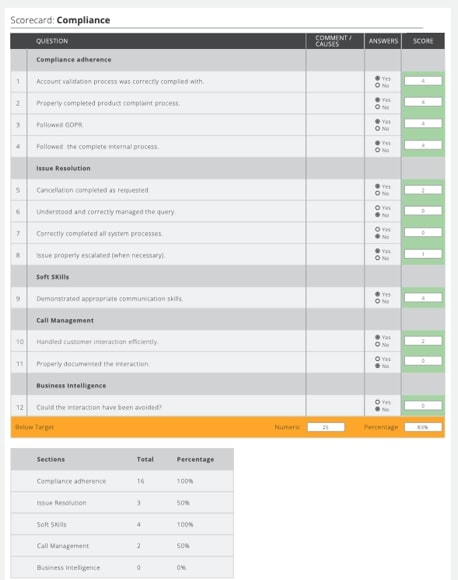
The ultimate goal of your customer service scorecards should be to help you figure out if you’re meeting your goals—internally and externally.
You need to know if all of the soft skills your agents demonstrate, the processes, channels, categorizing, and compliance monitoring result in the outcomes you want and need.
That’s why you should include outcomes questions on your scorecard, such as:
Outcomes take your scorecard beyond just a number to offer your call center tremendous value.
It helps you see if your criteria successfully provide a great customer experience, increase revenue, alleviate stress, and meet regulatory and process standards.

At the end of the day, a customer service scorecard must be able to tell you how satisfied your customers are with your performance.
Like NPS and Customer Satisfaction surveys, your scorecard should help your agents put themselves in custom customers and predict how happy they are with the customer experience.
It’s about proactively managing the customer experience.
The good news is that customer experience typically falls into five categories: time, performance, service, quality, and cost.
And you can measure most of this using your customer service scorecard:
Key performance indicators (KPIs) are invaluable tools for gathering and assessing data about the effectiveness of your call center, your agents, and your customer service.
These metrics provide feedback on everything that happens within your contact center to know precisely when it is performing in everything from sales to productivity, customer satisfaction, and quality.
There are a wide range of customer service-focused metrics that you can include on your scorecard.
Here’s a shortlist of customer-critical KPIs:
Lastly, there’s no reason you can’t use your customer service scorecards to track call center training.
After all, high-quality training is how your agents improve their performance, close knowledge gaps, increase their soft skills, and overall the customer experience.
Using your scorecard to monitor training, you can more easily manage, track, and achieve your learning goals. You can ask for feedback, such as:
Then, based on this feedback, make changes to your call center training program or sign up for a Learning Management System (LMS) like Scorebuddy’s new contact center LMS portal.
Once you’ve created your customer service scorecard, how do you use it in the contact center to achieve positive results in your customer service interactions?
It’s all about implementing a customer service workflow and software to keep you on track.
Scorebuddy’s scorecard system is essential for QA scoring and customer service management.
It is completely customizable, so you can capture the performance data that is most important to a quality customer experience.
You can then take the analytics and insights provided by Scorebuddy’s scorecards to take action and radically improve your quality of service in real-time.
By arming your contact center with customer service scorecards that uncover patterns, highlight trends, and identify strengths and weaknesses, you can make better decisions based on real insight.
This helps you service your customers better and provides them with an experience that exceeds their expectations. It also enables you to improve your contact center processes, meets regulatory standards, fill in training gaps, and develop more effective employees.
With Scorebuddy, your customers will have the best experience possible every time they interact with you.
Get started with a free customized tour of Scorebuddy today.